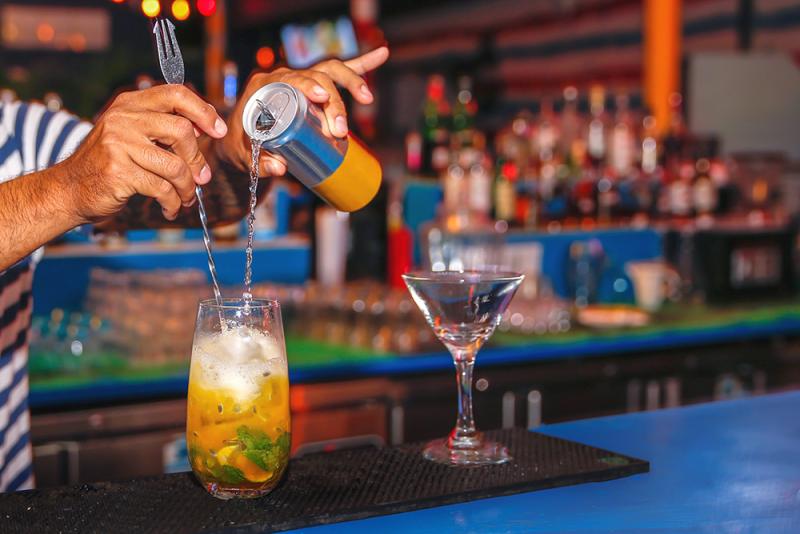By now, you’ve probably realized that the non-alc movement is not a passing fad. It may be here to stay, but what does that mean for your bar or restaurant? Is this something you really have to add to your menu?
If you’re looking for inclusivity and incremental revenue, the answer is yes!
Who is Drinking Non-Alc Products?
The short answer? Everyone. In fact, according to the IWSR Global No- and Low-Alcohol Strategic Study 2022, 82% of non-alc consumers also drink alcoholic beverages, while 83% of consumers choose to go between non-alc and alcohol-based drinks depending on the occasion.
“We're seeing a lot of people who are really interested in this for their own reasons, which is kind of like our company name—people are on their own roads,” says Chris Becker, founder/advisor of Better Rhodes, a curated online marketplace for non-alc beverages. “It's not about abstinence, it's about choice. And really focusing on how we can educate at such an early stage, not just customers, but now restaurant owners and others in the trade.”
And the demand for choice is there. According to a study by Casinos.us, 86% of Americans don’t have access to an establishment that focuses on non-alcoholic drink options, but 51% want access. The consumer is ready for non-alc options, the on-premise just has to deliver.
Why Are Consumers Choosing Non-Alc?
The first step in understanding the non-alc movement is that it’s not as important to know why customers are opting for non-alc beverages, it’s more about providing choices as a bar/restaurant for each of your customers.
“We're not about abstinence, we're about empowerment. So let's give people the opportunity to make the best decisions for them at that time, regardless of whether that's for the evening, a week, a month, a year, or if that's their new lifestyle,” says Daniel Stiller, CEO/co-founder of Better Rhodes. “Let's make the conversation about, ‘What are you drinking?’ Not, ‘Why aren't you drinking?’”
Stiller compares the rise of non-alc to the plant-based movement—it’s now expected that a restaurant will offer a vegetarian or plant-based option, and no one questions why a guest orders it. He expects the same to happen with non-alc. “Alcohol is the only addictive substance that we have to justify not taking,” he says. “We've done such an amazing job of romanticizing and glorifying [alcohol] that it's something that we have to justify not participating in because of the direct association between alcohol and conviviality. And to deny one is to deny the other. So when someone asks, ‘why aren't you drinking,’ it's not about your consumption of alcohol. The real question is, ‘Why don't you want to have fun?’”
Bars/restaurants have the power to eliminate this stigma by creating non-alc cocktails that are on par with their alcohol counterparts. This will legitimize non-alc beverages as a valid choice versus one that infantilizes the guest. “It's about challenging that narrative. I think there's no better place to challenge that narrative than in an on-premise environment,” says Stiller, who notes that the on-premise is all about providing conviviality and hospitality. “How do we allow everyone at the table to feel like they're participating? To feel that they're a valued member of the table?”

Non-Alc Drinkers Could Be Your Most Valuable Customers
If the concept of inclusivity isn’t enough to convince you that your bar/restaurant needs a non-alc section on the menu, then let’s talk about the opportunity for incremental revenue. It starts with valuing the customers who order non-alc beverages.
“When we talk about valuing a customer, what does that mean? Well, it's a price/cost equation, right?” says Stiller, who explains that it’s natural to view customers who order alcohol as higher value since alcohol purchases drive greater revenue, and the guests who drink typically stay longer and increase the check size. On the flip side, guests who order a soda or water are not as highly valued because they’re viewed as lost revenue.
Stiller argues that it’s time to change your view of these guests. Start to see them as possibly your highest value customers because they often determine how long the group stays, if they come back, and even where they choose to dine out. If there isn’t an option for a non-alc beverage on your menu other than lemonade or soda, they won’t enjoy the experience as much, will leave sooner, and may not come back. Similarly, if they know an establishment offers non-alc cocktails, they are more likely to steer the group toward that venue. If your venue is looking for a unique selling point, non-alc cocktails can be it—at least in the early stages of this non-alc movement.
Instead of worrying about dayparts and niche drink categories, Stiller says bars/restaurants should be focusing on the non-alc customer that is already looking for options. “You've got everyone spending all their time trying to figure out a dessert cocktail—hopefully you get them to dessert,” he says. “You've got someone who you could have been serving three drinks to the entire evening, and you haven't even thought about them yet. You just look at them as a loss….[Instead,] look at that person as the one that exponentially increases the sale of that table. As the one you've now turned from water to three glasses of wine, which also extends the stay.”
One other thing to consider is that statistic cited at the top of the article—over 80% of people who chose non-alc beverages also drink alcohol. “Maybe the next time that customer comes in, they will be ordering alcohol. It's just that at this time they're choosing not to. You're valuing the same person differently on two different occasions.”
Where to Place Non-Alc Beverages on a Menu
Of course, offering non-alc products is only half the battle—you have to be sure your team is trained on selling them and that they are also visible on your menu. The reality is many customers looking for non-alc options won’t ask because they are so used to receiving a poor response, or customers may not even know the option exists because the category is so new.
“Customers are suffering in silence,” says Becker. “If they know that there are adult, sophisticated drink options that don't include alcohol, they'll happily pay, but they often don't even know if these options exist. So we see it as not just a customer experience lift for a restaurant owner; it's a commercial lift as well because your average check size will go up.”
To make sure non-alc options are visible, don’t ostracize them to the bottom of the cocktail list as an afterthought. “I would suggest that it be in its own category, separate from the soft drinks and separate from the alcoholic drinks because of the education component. Most people wouldn't know to even look because they assume it's not there,” says Becker. “It has to start with educating people that it even exists. So it needs to be in its own section.”
It’s also important to make sure your staff is knowledgeable about the non-alc products on your menu—in the same way they would be with any products with alcohol. Does the brand have an interesting story? Do they know the flavor profile of the non-alc spirits and cocktails? Guests will most likely have questions about this burgeoning category, so make sure your staff is ready with answers.

As for which products to put on the menu, non-alc beer is always recommended. However, Better Rhodes also finds that non-alc wine and functional beverages are leading the pack. Functional beverages can include everything from kombucha to drinks with adaptogens and other beneficial ingredients. “These are products that offer a promise of some functional benefit,” says Becker. “We're starting to see an explosion.”
The demand for functional beverages is being outdone by the surge in popularity of non-alc wine. “Wine is a sleeper category that most restaurant owners don't recognize; it's the least mature,” says Becker. “But it's a category that outsells all other segments in our customer base two to one, which is interesting because the flavor gap is actually the greatest in wine.”
The elusive great-tasting non-alc wine is due to the process of dealcoholizing wine. Whereas beer can be brewed with very little to no alcohol using the right yeast, the alcohol must be removed from wine after it is made at full strength. This is a harsh process, which affects the quality of the product.
“Two things are happening. One is people are buying the [non-alc wine] anyway because they enjoy the other aspects of the experience in addition to the flavor,” says Becker. “The second thing is the flavor gap is closing. So we're working with more and more producers where innovation is happening. I always joke if we can put a man on the moon, we can come up with a good tasting, alcohol-free wine.”
What You Should Charge for Non-Alc Drinks
There is much debate—on both the consumer and the business side—on the cost of non-alc drinks. Again, much of this comes down to education. For instance, the process of dealcoholizing is often more expensive than the cost to create an alcoholic product—leading to a higher cost for some non-alc products.
But thanks to the persistent narrative that non-alc beverages are “less than” alcoholic products, the consumer believes the cost should be less than as well. By legitimizing these products as a viable category and choice, the acceptance of cost will naturally follow.
Stiller again compares the rise of non-alc beverages to the rise of the plant-based movement. Consumers now accept the higher price of those products because of the perceived health benefits. He expects the same to happen with non-alc, if it isn’t already. “The consumers that we deal with have overwhelmingly said, ‘I'm not doing this to save money, I'm doing this for health and wellness. I'm making this transition to be a better version of myself,’” he says.
The Casino.us study found that 67% said they were trying to reduce alcohol consumption, and the number-one reason for this—reported by 41% of drinkers—is that they want a lifestyle change.
Stiller also notes that the lack of knowledge about the non-alc space could also positively influence price perception. “When we don't have a ton of knowledge about the space, then we're going to base our purchase on price, and we associate price with quality. So I think what we're seeing is the customer saying, ‘Hey, I'll spend money on a quality experience.’ And it speaks to the premiumization.”
On the business side, Stiller encourages bar/restaurant owners to reframe their questions about the cost of non-alc. Instead of asking how much it costs to bring in, they should be asking how much additional revenue non-alc cocktails can bring in versus water, soda, etc.
Are you registered for our Crave and Crave on the Menu newsletters? Sign up today!
Plan to Attend or Participate in the 2024 Bar & Restaurant Expo, March 18-20, 2024
To learn about the latest trends, issues and hot topics, and to experience and taste the best products within the bar, restaurant and hospitality industry, plan to attend Bar & Restaurant Expo 2024 in Las Vegas. Visit BarandRestaurantExpo.com.
To book your sponsorship or exhibit space at the 2024 Bar & Restaurant Expo, contact:
Veronica Gonnello (for companies A to G) e: [email protected] p: 212-895-8244
Tim Schultz (for companies H to Q) e: [email protected] p: 917-258-8589
Fadi Alsayegh (for companies R to Z) e: [email protected] p: 917-258-5174
Also, be sure to follow Bar & Restaurant on Facebook and Instagram for all the latest industry news and trends.
